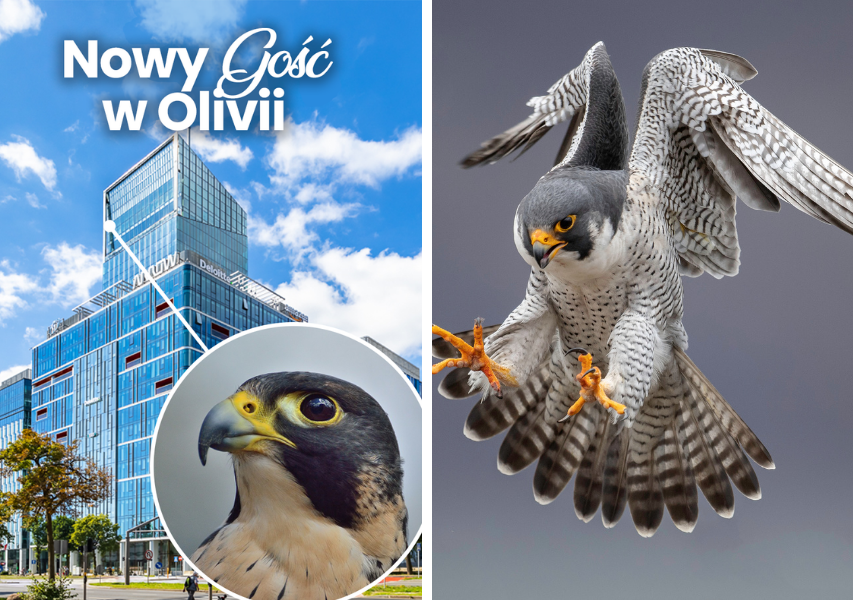On March 3rd, we celebrated World Wildlife Day. This is a perfect opportunity to mention Olivia’s Guest, who is the fastest in the world and visits us quite regularly. Who is it? Peregrine falcon!
Lightning fast
The Peregrine Falcon (Falco Peregrinus) is the absolute speed record holder – not only among birds, but among all animals on Earth. Let us emphasize once again that the fastest moving organism on the planet. Its fastest flight, recorded by man, was from speed of 322 km/h, although some declare that the falcon can fly even over 400 km/h. A man named Ken Franklin (Greifvögel und Falknerei, 1999) reached a speed of 400 km/h with his falcon from great heights and thinks it could be even higher.
The Peregrine Falcon holds one more record – it is the species of bird of prey with the largest range. There are few places on Earth where it does not exist – these are m.in. polar regions, tropical forests, Iceland and New Zealand.
The peregrine falcon is one of the larger representatives of its family, the male grows up to 45 cm in length and has a wingspan of 100 cm, while the female can reach 51 cm and a wingspan of up to 115 cm.
The Peregrine Falcon does not roam
The peregrine falcon, contrary to its name, cannot be classified as a migratory species. The use of this nickname in many languages, e.g. “Wanderfalke” in German, “Peregrine” in English or “Pellegrino” in Italian, probably comes from the times when falconers caught young migratory birds, best suited for hunting purposes. With very few exceptions, the peregrine falcon is practically a sedentary species.
Otto Kleinschmidt, a German pastor, wrote in 1912 about the peregrine falcon: “There is no other bird that is more attached to its homeland and breeding ground than the peregrine falcon.” On the other hand, one of the doyens of Polish ornithology, Count Kazimierz Antoni Wodzicki, noted: “Of all the falcons, it wanders the least, and in many places it roams all year round, e.g. in cities, churches and towers.” Prof. Jan Sokolowski also drew attention to the unfortunate choice of the name: “The name of this species ‘migratory’ is not happily chosen (…). Our peregrine falcon wanders more or less in the first year of its life, but later on it settles permanently and ventures at most on small excursions in the country, which have nothing to do with regular migrations.”
Sloth among birds
Experts on the subject say that the peregrine falcon is one of the laziest birds. While, for example, a hawk hunts until it succeeds, a falcon will only attempt to attack a few times. If it does not manage to catch its prey, it gives up, sits down in a quiet place and rests, sometimes even until the next day.
He also doesn’t want to build a nest. A piece of sheltered ledge, a hole or hole in a tall building, an abandoned nest of another bird of similar size, and a ground brood in the far north are enough for these birds.
The Falcon Is Faithful
Falcons are referred to as serial monogamists. This means that, in fact, the pair is created anew every year (spring and autumn mating), but due to strong territoriality, if both individuals from the pair are alive, they form a pair again.
Falcon in Danger
Until the 1940s. The peregrine falcon nested in all regions of Polish, although in decreasing numbers. In the late 1950s. A catastrophic decline in the number of this species began, which was influenced by environmental pollution. Between 1958 and 1960, only five falcon nests were recorded in Wielkopolska. The nests spotted in Pomerania (near Goleniów, Człuchów and in the Tuchola Forest) were among the last.
Rescue
It was not until the late 1990s that a group of falconers saved these beautiful birds from extinction. Thanks to this, we can again enjoy their sight in Polish cities (where most of the native peregrine falcons nest), in forests and by water reservoirs – here fleeting individuals like to winter. Efforts to restore and reintroduce* the population of the species are coordinated by the Council of the Peregrine Falcon Restitution Program in Poland.

The Falcon Loves Skyscrapers
A huge metropolis, New York City is a favorite destination for peregrine falcons. It is home to the world’s largest population of these birds of prey. Their nests are located on bridges and skyscrapers on the outskirts of the city.
Falcon on the highest nest in Northern Poland
The falcon in Olivia Business Centre joins other Tri-City falcons nesting on the premises of PGE EC Gdynia and LOTOS Gdańsk. You will be able to see our falcon soon (we captured it for a while, it wasn’t easy!) on Olivia’s Facebook page.
One of the falcon pairs has been nesting at the Palace of Culture and Science in Warsaw since 1998. Internet transmission is carried out from the nests at the Palace of Culture and Science, in Warsaw’s Bielany district, on the chimney of MPEC in Włocławek, KGHM in Głogów, LOTOS in Gdańsk and PGE EC Gdynia.
Reintroduction – reintroduction of a species that has become extinct for some reason or whose previous attempts to introduce it have failed. The reintroduction method may also apply to those animal and plant species whose numbers in a given area have drastically decreased and are negligible, and thus are threatened with extinction.
Origin:




